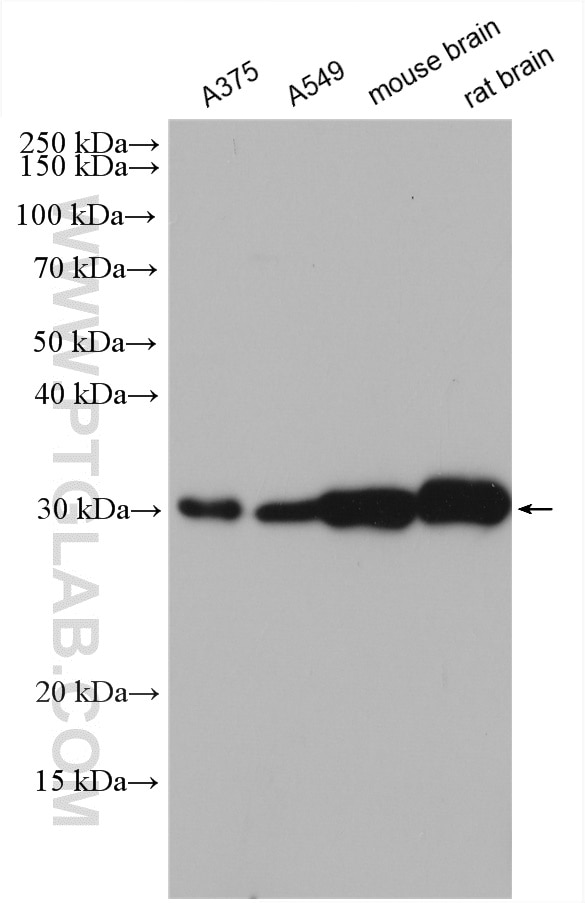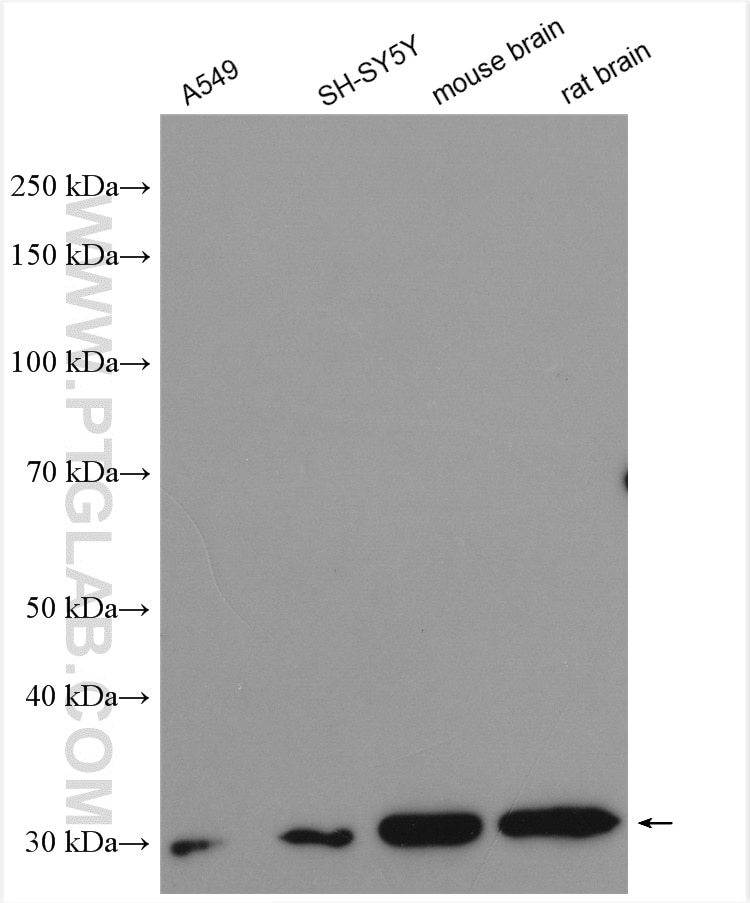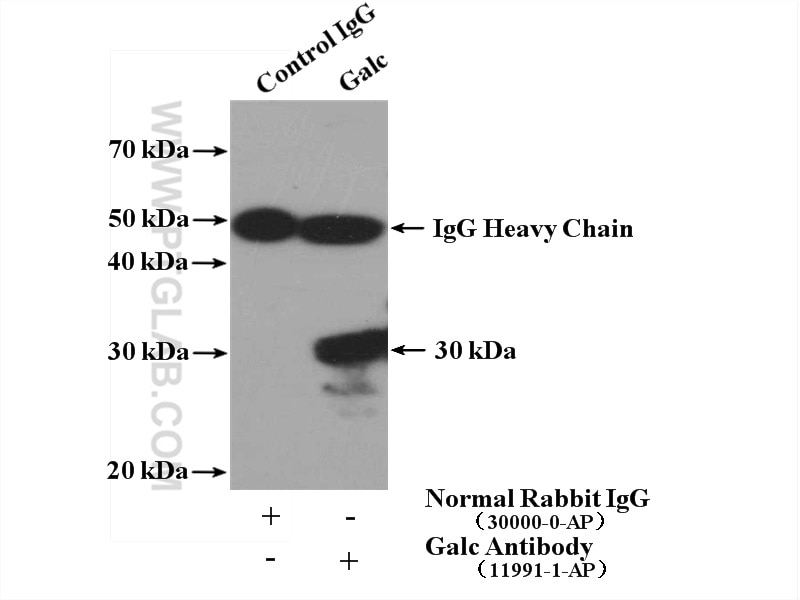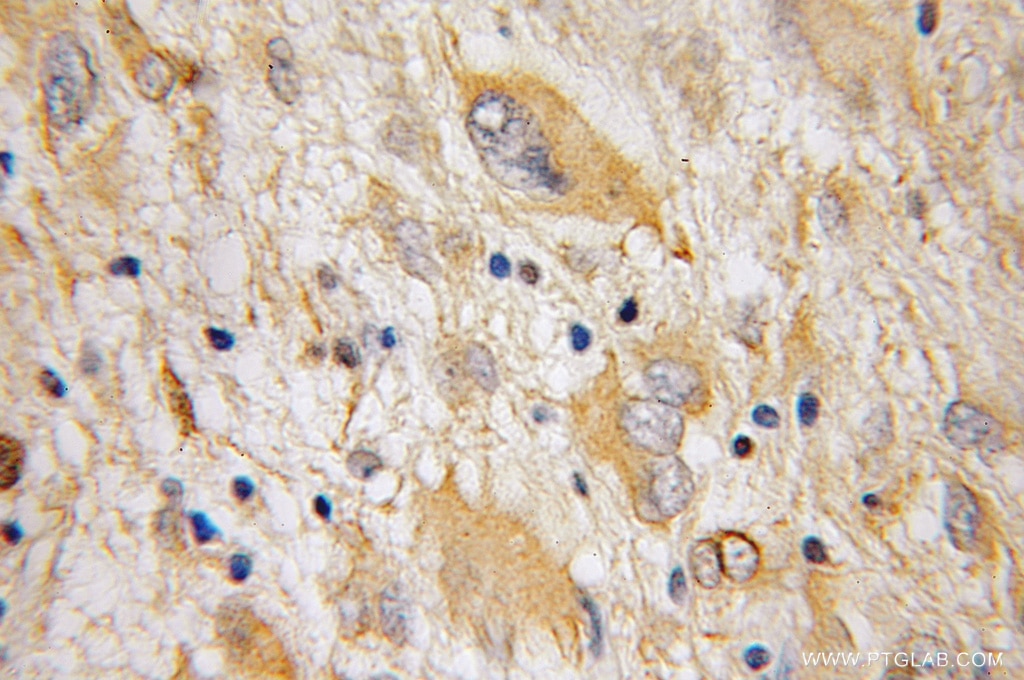- Phare
- Validé par KD/KO
Anticorps Polyclonal de lapin anti-Galc
Galc Polyclonal Antibody for WB, IP, IHC, ELISA
Hôte / Isotype
Lapin / IgG
Réactivité testée
Humain, rat, souris et plus (1)
Applications
WB, IP, IF, IHC, ELISA
Conjugaison
Non conjugué
N° de cat : 11991-1-AP
Synonymes
Galerie de données de validation
Applications testées
| Résultats positifs en WB | cellules A375, cellules A549, cellules SH-SY5Y, tissu cérébral de rat, tissu cérébral de souris |
| Résultats positifs en IP | cellules NIH/3T3 |
| Résultats positifs en IHC | tissu de gliome humain il est suggéré de démasquer l'antigène avec un tampon de TE buffer pH 9.0; (*) À défaut, 'le démasquage de l'antigène peut être 'effectué avec un tampon citrate pH 6,0. |
Dilution recommandée
| Application | Dilution |
|---|---|
| Western Blot (WB) | WB : 1:500-1:1000 |
| Immunoprécipitation (IP) | IP : 0.5-4.0 ug for 1.0-3.0 mg of total protein lysate |
| Immunohistochimie (IHC) | IHC : 1:20-1:200 |
| It is recommended that this reagent should be titrated in each testing system to obtain optimal results. | |
| Sample-dependent, check data in validation data gallery | |
Applications publiées
| KD/KO | See 1 publications below |
| WB | See 9 publications below |
| IHC | See 3 publications below |
| IF | See 7 publications below |
Informations sur le produit
11991-1-AP cible Galc dans les applications de WB, IP, IF, IHC, ELISA et montre une réactivité avec des échantillons Humain, rat, souris
| Réactivité | Humain, rat, souris |
| Réactivité citée | rat, Humain, poisson-zèbre, souris |
| Hôte / Isotype | Lapin / IgG |
| Clonalité | Polyclonal |
| Type | Anticorps |
| Immunogène | Galc Protéine recombinante Ag3914 |
| Nom complet | galactosylceramidase |
| Masse moléculaire calculée | 77 kDa |
| Poids moléculaire observé | 80 kDa, 30 kDa, 50 kDa |
| Numéro d’acquisition GenBank | BC086671 |
| Symbole du gène | Galc |
| Identification du gène (NCBI) | 14420 |
| Conjugaison | Non conjugué |
| Forme | Liquide |
| Méthode de purification | Purification par affinité contre l'antigène |
| Tampon de stockage | PBS avec azoture de sodium à 0,02 % et glycérol à 50 % pH 7,3 |
| Conditions de stockage | Stocker à -20°C. Stable pendant un an après l'expédition. L'aliquotage n'est pas nécessaire pour le stockage à -20oC Les 20ul contiennent 0,1% de BSA. |
Informations générales
The GALC antibody targets the liposomal enzyme Galactosylceramidase (GALC), which belongs to the glycosyl hydrolase 59 family. It hydrolyzes the galactose ester bonds of galactosylceramide, galactosylsphingosine, lactosylceramide, and monogalactosyldiglyceride. It is primarily found in the brain and kidneys where galactolipids are hydrolyzed (PMID:8634707). Deficiencies of GALC are primarily associated with the autosomal recessive Krabbe's disease. This disease is characterized by developmental delay caused by apoptosis of myelin-forming cells. GALC is responsible for hydrolyzing galactosylceramide, a cerebroside that is an important component of myelin. A deficiency in GALC causes loss of myelin to nerve cells, resulting in delayed nerve transmissions. Krabbe's disease has varying degrees of severity due to a large number of different genetic mutations in the gene. The GALC antibody can be used to detect the deletions in the GALC gene and functions of the enzyme (PMID:20886637). Normal GALC mRNA encodes the 80 kDa precursor, which is processed into 50 and 30 kDa subunits (PMID: 26865610).
Protocole
| Product Specific Protocols | |
|---|---|
| WB protocol for Galc antibody 11991-1-AP | Download protocol |
| IHC protocol for Galc antibody 11991-1-AP | Download protocol |
| IP protocol for Galc antibody 11991-1-AP | Download protocol |
| Standard Protocols | |
|---|---|
| Click here to view our Standard Protocols |
Publications
| Species | Application | Title |
|---|---|---|
Dev Cell NPC1-mTORC1 Signaling Couples Cholesterol Sensing to Organelle Homeostasis and Is a Targetable Pathway in Niemann-Pick Type C. | ||
Stem Cells Multipotent Stromal Cells Alleviate Inflammation, Neuropathology, and Symptoms Associated with Globoid Cell Leukodystrophy in the Twitcher Mouse. | ||
Mol Ther AAV-mediated expression of galactocerebrosidase in brain results in attenuated symptoms and extended life span in murine models of globoid cell leukodystrophy. | ||
Mol Ther Extended normal life after AAVrh10-mediated gene therapy in the mouse model of Krabbe disease. | ||
Glia Ncx3 gene ablation impairs oligodendrocyte precursor response and increases susceptibility to experimental autoimmune encephalomyelitis. | ||
FASEB J Polyunsaturated fatty acid deficiency affects sulfatides and other sulfated glycans in lysosomes through autophagy-mediated degradation. |





